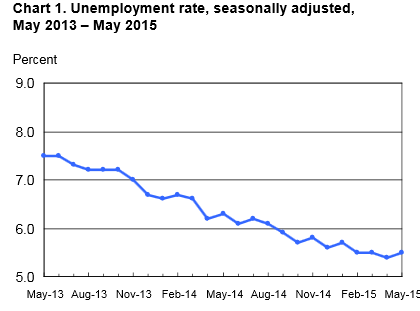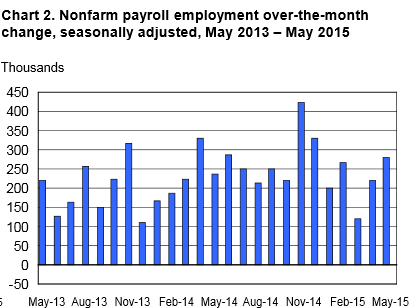June Employment Blog
This report is from the Bureau of Labor Statistics, US Department of Labor. Non-farm payroll employment rose by 280,000 in May, and the unemployment rate was essentially unchanged at 5.5percent. Employment rose in professional and business services, leisure and hospitality, and health care. Job losses continued in mining. Incorporating the revisions for March and April , which increased non-farm employment by 32,000, on net, monthly job gains have averaged 207,000 over the past 3 months. In the 12 months prior to May, employment growth averaged 251,000 per month. This information is summarized in Charts 1 and 2 below.
Employment in professional and business services rose by 6,000 in May and by 671,000 over the year. Within the industry, computer systems design and related services added 10,000 jobs in May. Employment continued to trend up in temporary help services (+20,000), in management and technical consulting services (+7,000), and in architectural and engineering services (+5,000).
Employment in leisure and hospitality increased by 57,000 over the month, after changing little in the prior 2 months. Employment in arts, entertainment, and recreation edged up in May (+29,000). Employment in food services and drinking places has shown little net change over the past 3 months.
Employment in health care increased by 47,000 in May and has grown by 408,000 over the year. Ambulatory health care services (+28,000) and hospitals (+16,000) added jobs over the month.
Retail trade employment edged up in May (+31,000). Over the prior 12 months, the industry had added an average of 24,000 jobs per month. In May, automobile dealers added 8,000 jobs.
Employment continued to trend up in May in construction (+17,000), transportation and warehousing (+13,000), and financial activities (+13,000).
Manufacturing employment changed little for the fourth month in a row. The industry had added an average of 18,000 jobs per month from January 2014 to January 2015.
Mining lost 17,000 jobs in May. The decrease was in support activities for mining, which include those for oil and gas operations. Employment in mining has fallen by 68,000 thus far in 2015, more than offsetting the 41,000 jobs gained during 2014.
Average hourly earnings of all employees on private non-farm payrolls rose by 8 cents in May to $24.96. Over the past 12 months, average hourly earnings have risen by 2.3 percent. From April 2014 to April 2015, the Consumer Price Index for All Urban Consumers (CPI-U) declined by 0.1 percentage point (on a seasonally adjusted basis).
Turning now to data from our survey of households, both the unemployment rate, at 5.5 percent, and the number of unemployed persons, at 8.7 million, were essentially unchanged in May and have shown little movement since February. Among those unemployed in May, 28.6 percent had been jobless for 27 weeks or longer. Both the number of long-term unemployed and their share of total unemployment have fallen over the past 12 months. The civilian labor force rose by 397,000 in May. The labor force participation rate, at 62.9 percent, changed little over the month and has remained within a narrow range of 62.7 percent to 62.9 percent since April 2014. The employment-population ratio was essentially unchanged, at 59.4 percent, in May. The number of persons employed part time for economic reasons was about unchanged at 6.7 million in May and has shown little movement in recent months. These individuals, who would have preferred full-time employment, were working part time because their hours had been cut back or because they were unable to find full-time work. Among people who were neither working nor looking for work in May, 1.9million were classified as marginally attached to the labor force, down by 268,000 over the year. These individuals had not looked for work in the 4 weeks prior to the survey but wanted a job, were available for work, and had looked for a job within the last 12 months. The number of discouraged workers, a subset of the marginally attached who believed that no jobs were available for them, was 563,000 in May, down by 134,000 over the year.
Civilian Workers Compensation costs for civilian workers increased 2.6 percent for the 12-month period ending March 2015, rising from the March 2014 increase in compensation costs of 1.8 percent. Wages and salaries increased 2.6 percent for the 12-month period ending March 2015, which was higher than the 1.6-percent increase in March 2014. Benefit costs increased 2.7 percent for the 12-month period ending March 2015, compared with a 2.1-percent increase for the 12-month period ending March 2014. See Chart 2a.



